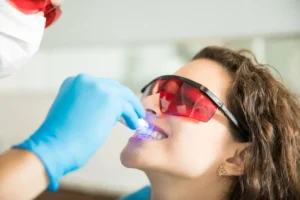A dental crown procedure is a common treatment for restoring a decayed or damaged tooth. Understanding the process can help alleviate any anxiety and prepare you for the procedure.
Step-by-Step Guide to the Crown Procedure:
- Initial Consultation: Your dentist will assess your tooth and may recommend a crown as the best course of action.
- Tooth Preparation: The decayed or damaged part of the tooth is removed, and the tooth is shaped to fit the crown.
- Impressions: Impressions of your prepared tooth and surrounding teeth are taken for crown fabrication.
- Temporary Crown: A temporary crown is placed while your permanent crown is being made.
- Crown Fabrication: Using Computer-Aided Design (CAD) and Computer-Aided Manufacturing (CAM), your custom crown is created, ensuring a precise fit and aesthetic match with your natural teeth.
- Crown Placement: Once your permanent crown is ready, the temporary crown is removed, and the new crown is securely fitted and adjusted for comfort and bite alignment.
- Final Adjustments: Your dentist will make any necessary adjustments to ensure the crown feels natural and comfortable.
Types of Crowns Used in the Procedure:
- Porcelain Crowns: Popular for their natural appearance, suitable for front teeth.
- Metal Crowns: Durable and strong, often used for back teeth.
- Porcelain Fused to Metal (PFM) Crowns: A combination of strength and aesthetics.
Advanced Technology in Crown Fabrication:
Modern dental practices may use advanced technology like CAD/CAM for designing and creating crowns. This technology allows for more precise and quicker fabrication of crowns, sometimes even in the same day.
Post-Procedure Care:
After the procedure, it’s important to maintain good oral hygiene and regular dental check-ups to ensure the longevity of the crown and overall oral health.
In conclusion, a dental crown procedure is a multi-step process that involves careful preparation, advanced technology, and meticulous placement to restore your tooth’s function and appearance. Understanding these steps can help you feel more comfortable and informed about the procedure.








